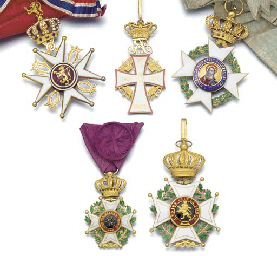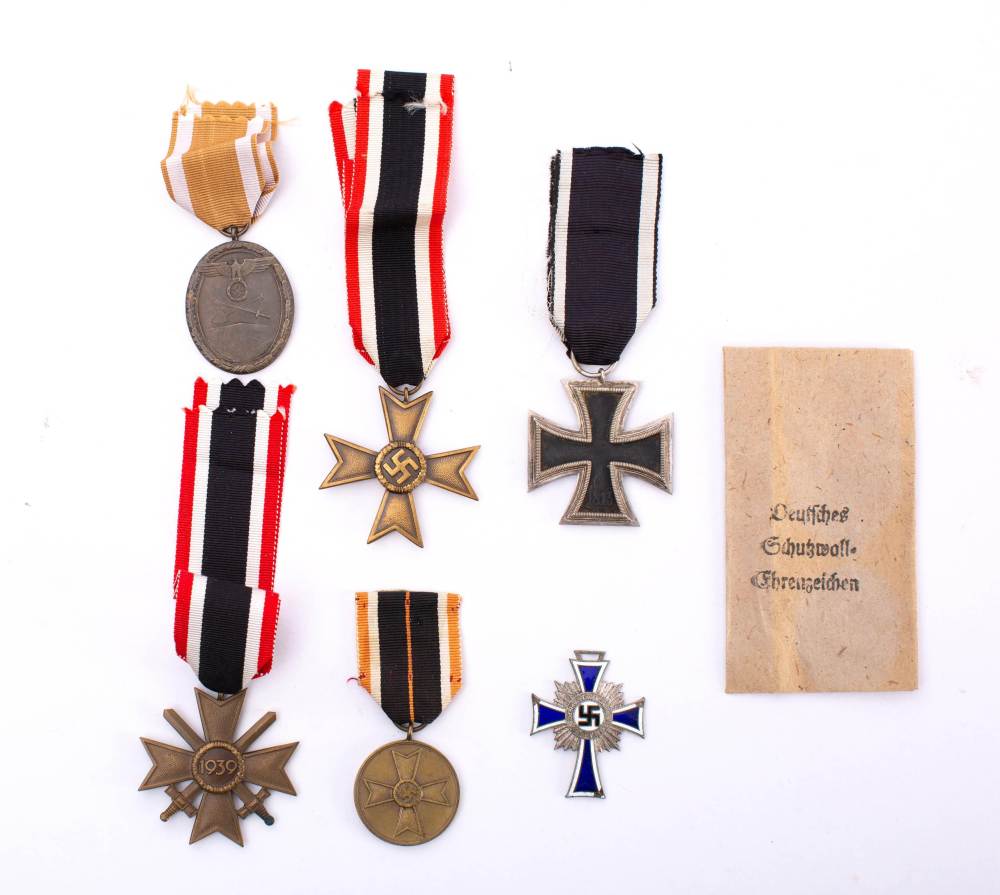The Orders and Decorations of General Sir Tomkyns Hilgrove Turner, G.C.H., K.C. Russia, Order of St Anne, 1st type, Grand Cross sash badge by Andreas Paskewitz, St Petersburg, circa 1814, gold with enamelled centres, the four arms each set with a red crystal in a silver mount, the angles of the cross each set with a single pear-shaped paste stone in a silver mount, and the points of each arm set with three smaller round pastes in silver mounts, 82mm x 71mm excluding suspension ring, the reverse suspension loop with maker’s mark ‘A.P’ and St Petersburg assay office mark, test mark to reverse, otherwise nearly extremely fine, a highly important fully provenanced badge awarded to the first British recipient of this Order £60000-80000 Footnote After the defeat of Napoleon in 1814 and his exile to Elba, and in preparation for the Inter-Allied conference which took place later in Vienna, the monarchs of the Grand Alliance were invited to visit London. Alexander 1, Tsar of Russia, and King Frederick William III of Prussia accepted, but the Austrian Emperor refused and sent Prince Metternich in his stead. The King of Prussia was accompanied by Blücher and Hardenburg, while the Tsar was preceded by his sister, the Archduchess Catherine of Russia, who was also the widow of the Grand Duke of Oldenburg. General Turner was appointed by the Prince Regent to attend on the Grand Duchess and to make all the arrangements for her stay in London and for a tour of some of the towns and great country houses of England. He was present at many of the state and social functions given to the Allied Sovereigns, and has left some interesting memoranda and correspondence illustrating the intrigues of the representatives of the various nations, the characters of the actors, and the open antipathy between the Prince Regent and the Duchess of Oldenburg, all contributing factors towards the eventual triple alliance of France, England and Austria, and the rape of Poland by Russia and Prussia. For General Turner’s service to the Grand Duchess and the Emperor during their tour of England, the Emperor made him a Knight Grand Cross of the Order of St Anne, of which order he is believed to be the first British recipient. Advised of the honour in a letter from Count Lieven dated 8 July 1814, the General went to considerable trouble to obtain permission to wear this order, as there existed a prohibition against the wearing of foreign decorations. In support of his claim he made the following 'Statement of Services': ‘Statement of Services of Lieut.-Genl. Sir Hilgrove Turner. Who served in all the actions of the Campaigns of 1793-94-95 in Holland, Flanders, France, and Germany in the last part of 1794 he had the rank of Field Officer. In the actions of the campaign in Egypt in 1801, in the latter part of which he served as a General Officer. He was ordered with troops to South America in 1807, arrived in the Rio de la Plata, tho’ too late for the action at Buenos Aires and was under the necessity of going with the troops to the Brazils and Cape of Good Hope. He had the honour of the charge of the monuments taken in Egypt and now deposited in the British Museum which were obtained with considerable expense and risk on his part. He commanded a body of troops in Jersey, which effected a forcible landing with the Duc d'Aumont on the coast of Normandy, to aid and assist the operations of the allies in their entrance into France, at Caen bv detaining a large body of troops from joining the great army on the frontiers last year 1815 and for which he has had the honour to receive a letter of approbation from His Majesty’s Secretary of State for the War Department.’ (Ref Sir Hilgrove Turner, Soldier and Courtier under the Georges, Arthur F. Loveday, Alkham Press, 1964).
The Orders and Decorations of General Sir Tomkyns Hilgrove Turner, G.C.H., K.C. Russia, Order of St Anne, 1st type, Grand Cross sash badge by Andreas Paskewitz, St Petersburg, circa 1814, gold with enamelled centres, the four arms each set with a red crystal in a silver mount, the angles of the cross each set with a single pear-shaped paste stone in a silver mount, and the points of each arm set with three smaller round pastes in silver mounts, 82mm x 71mm excluding suspension ring, the reverse suspension loop with maker’s mark ‘A.P’ and St Petersburg assay office mark, test mark to reverse, otherwise nearly extremely fine, a highly important fully provenanced badge awarded to the first British recipient of this Order £60000-80000 Footnote After the defeat of Napoleon in 1814 and his exile to Elba, and in preparation for the Inter-Allied conference which took place later in Vienna, the monarchs of the Grand Alliance were invited to visit London. Alexander 1, Tsar of Russia, and King Frederick William III of Prussia accepted, but the Austrian Emperor refused and sent Prince Metternich in his stead. The King of Prussia was accompanied by Blücher and Hardenburg, while the Tsar was preceded by his sister, the Archduchess Catherine of Russia, who was also the widow of the Grand Duke of Oldenburg. General Turner was appointed by the Prince Regent to attend on the Grand Duchess and to make all the arrangements for her stay in London and for a tour of some of the towns and great country houses of England. He was present at many of the state and social functions given to the Allied Sovereigns, and has left some interesting memoranda and correspondence illustrating the intrigues of the representatives of the various nations, the characters of the actors, and the open antipathy between the Prince Regent and the Duchess of Oldenburg, all contributing factors towards the eventual triple alliance of France, England and Austria, and the rape of Poland by Russia and Prussia. For General Turner’s service to the Grand Duchess and the Emperor during their tour of England, the Emperor made him a Knight Grand Cross of the Order of St Anne, of which order he is believed to be the first British recipient. Advised of the honour in a letter from Count Lieven dated 8 July 1814, the General went to considerable trouble to obtain permission to wear this order, as there existed a prohibition against the wearing of foreign decorations. In support of his claim he made the following 'Statement of Services': ‘Statement of Services of Lieut.-Genl. Sir Hilgrove Turner. Who served in all the actions of the Campaigns of 1793-94-95 in Holland, Flanders, France, and Germany in the last part of 1794 he had the rank of Field Officer. In the actions of the campaign in Egypt in 1801, in the latter part of which he served as a General Officer. He was ordered with troops to South America in 1807, arrived in the Rio de la Plata, tho’ too late for the action at Buenos Aires and was under the necessity of going with the troops to the Brazils and Cape of Good Hope. He had the honour of the charge of the monuments taken in Egypt and now deposited in the British Museum which were obtained with considerable expense and risk on his part. He commanded a body of troops in Jersey, which effected a forcible landing with the Duc d'Aumont on the coast of Normandy, to aid and assist the operations of the allies in their entrance into France, at Caen bv detaining a large body of troops from joining the great army on the frontiers last year 1815 and for which he has had the honour to receive a letter of approbation from His Majesty’s Secretary of State for the War Department.’ (Ref Sir Hilgrove Turner, Soldier and Courtier under the Georges, Arthur F. Loveday, Alkham Press, 1964).

.jpg)
.jpg?w=400)



.jpg)








Testen Sie LotSearch und seine Premium-Features 7 Tage - ohne Kosten!
Lassen Sie sich automatisch über neue Objekte in kommenden Auktionen benachrichtigen.
Suchauftrag anlegen